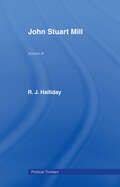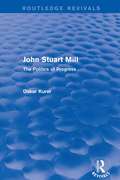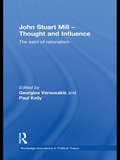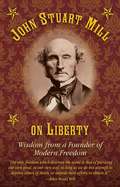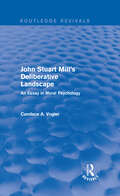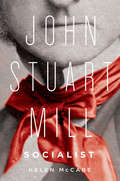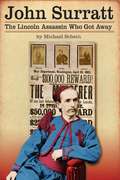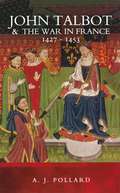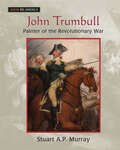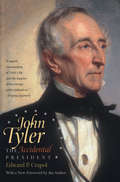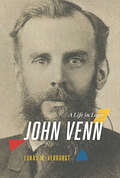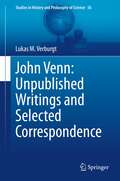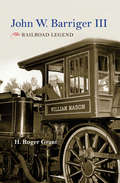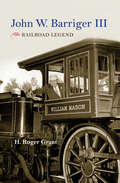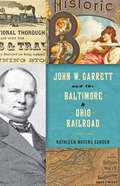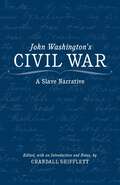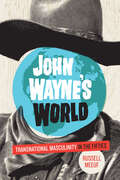- Table View
- List View
John Stewart Collis: A Memoir
by Richard IngramsJohn Stewart Collis was a remarkable writer about nature in the tradition of W. H. Hudson and Richard Jefferies. He was born in Dublin; after Rugby and Oxford he became a farm labourer during the war--an experience which inspired his book "The Worm Forgives the Plough, "now widely regarded as a classic. He wrote a number of books about scientific phenomena but only achieved recognition with the publication in the 1970s of his autobiography, "Bound Upon a Course." After a lifetime of misfortune and neglect, his last years were a period of great happiness and fulfillment. He married again and became a regular contributor to the Spectator. Richard Ingrams was a close friend of these years; he has written a perceptive, affectionate account of a formidably unusual man whose unique personality is the stuff of great biography.
John Stuart Mill
by R J Halliday R. J. HallidayFirst published in 1976, this volume offers a significant new interpretation of Mill's political thought, Mill's ambivalent attitude to democracy is carefully examined. The implications for modern democracy of Mill's views on consensus and leadership, bureaucracy and participation, equality and liberty emerge from a deep understanding of Mill's place in 19th century ideas.
John Stuart Mill (Routledge Revivals): The Politics of Progress
by Oskar KurerFirst published in 1991, this book attempts to deal with Mill’s thought as a coherent system and tie some elements of his thoughts together. It seeks to show that he developed a set of ethical principles to underlie government intervention and provide a theory as to how it should intervene — which he then applied to practical politics. The first chapters deal with Mill’s doctrine of improvement and what impact the improvement of man has on the social organisation of society. The third chapter deals with Mill’s theory of economic development. The second part of the book deals with policy issues such as the question of the optimal constitution and Mill’s policy proposals for England.
John Stuart Mill - Thought and Influence: The Saint of Rationalism (Routledge Innovations in Political Theory)
by Georgios VarouxakisMore than two hundred years after his birth, and 150 years after the publication of his most famous essay On Liberty, John Stuart Mill remains one of the towering intellectual figures of the Western tradition. This book combines an up-to-date assessment of the philosophical legacy of Mill’s arguments, his complex version of liberalism and his account of the relationship between character and ethical and political commitment. Bringing together key international and interdisciplinary scholars, including Martha Nussbaum and Peter Singer, this book combines the latest insights of Mill scholarship with a long-term appraisal of the ways in which Mill’s work has been received and interpreted from the time of his death in 1873 to today. The book offers compelling insights into Mill’s posthumous fate and reputation; his youthful political and intellectual activism; his views on the formation of character; the development of his thought on logic; his differences from his father and Bentham; his astonishingly prescient, environmentally sensitive and ‘green’ thought; his relation to virtue ethics; his conception of higher pleasures and its relation to his understanding of justice; his feminist thought and its place in contemporary debates and feminist discourses; his defence of free speech and its fundamental significance for his liberalism; and his continued contemporary relevance on a number of major issues. This book will be of interest to students and scholars of Politics, Political Theory, Philosophy, History, English, Psychology, and also Cultural Studies, Empire studies, nationalism and ethnicity studies.
John Stuart Mill and Freedom of Expression: The Genesis of a Theory (Routledge Studies in Social and Political Thought)
by K.C. O'RourkeThe arguments advanced in the second chapter of On Liberty (1859) have become the touchstone for practically every discussion of freedom of speech, yet the broader development of John Stuart Mill's ideas concerning intellectual liberty has generally been neglected. This work attempts to fill that lacuna by looking beyond On Liberty, in order to understand the evolution of Mill's ideas concerning freedom of thought and discussion.
John Stuart Mill on Tyranny and Liberty: Wisdom from a Founder of Modern Freedom
by Joseph HealyThe United States was founded on the importance of civil liberties--protections for the individual against the control of others, whether those are other people or the government. Freedom for each person is a cornerstone of Western society.<P><P> John Stuart Mill's thoughts on liberty and the concept of freedom are among the most important frameworks on which we've built so much of modern society; our very ideas of limited government and personal freedom are rooted in the writings of this great political philosopher. John Stuart Mill on Liberty is a collection of some of the most important of his statements on the ideas of liberty and freedom. This book showcases his firm belief that each person should have the right to live as he or she wants to, so long as it does not harm anyone else. Much of what we now take for granted or still fight to maintain or advance, such as freedom of speech, the abolition of slavery, and the rights of women, are things Mill argued for. As you read his passionate entreaties for liberty, you'll be amazed at how relevant and important they remain today. "In this age, the mere example of non-conformity, the mere refusal to bend the knee to custom, is itself a service. " --John Stuart Mill
John Stuart Mill's Deliberative Landscape: An Essay in Moral Psychology (Studies In Ethics Ser.)
by Candace A. VoglerFirst published in 2001, this book sets out to shed light on traditional controversies in Mill scholarship, underscore the significance of the contribution Mill made to associationist psychology, argue he is not entirely successful in explaining why art matters, and that this failure is linked to a deep tension in his mature work — rooted in his unwillingness to shake off the moral psychology he was raised on. The book examines various episodes and tensions in Mill’s life and work and how they relate to and informed his philosophy — while also giving a critical account of it. This book will be of interest to students of philosophy.
John Stuart Mill, Socialist
by Helen McCabeBest known as the author of On Liberty, John Stuart Mill remains a canonical figure in liberalism today. Yet according to his autobiography, by the mid-1840s he placed himself "under the general designation of Socialist." Taking this self-description seriously, John Stuart Mill, Socialist reinterprets Mill's work in its light.Helen McCabe explores the nineteenth-century political economist's core commitments to egalitarianism, social justice, social harmony, and a socialist utopia of cooperation, fairness, and human flourishing. Uncovering Mill's changing relationship with the radicalism of his youth and his excitement about the revolutionary events of 1848, McCabe argues that he saw liberal reforms as solutions to contemporary problems, while socialism was the path to a better future. In so doing, she casts new light on his political theory, including his theory of social progress; his support for democracy; his feminism; his concept of utility; his understanding of individuality; and his account of "the permanent interests of man as a progressive being," which is so central to his famous harm principle.As we look to rebuild the world in the wake of financial crises, climate change, and a global pandemic, John Stuart Mill, Socialist offers a radical rereading of the philosopher and a fresh perspective on contemporary meanings of socialism.
John Surratt: The Licoln Assassin Who Got Away
by Michael ScheinWho was JOHN SURRATT? A pitiless assassin who hid while his mother was hanged for his crime? A Southern patriot falsely accused of Lincoln's murder? This is the last untold story of the Lincoln assassination - an impeccably researched page-turning account of the Confederate spy who was Booth's closest associate prior to the assassination; the man who carried orders from Richmond to Washington, then got away with the crime of the century. Get ready for a thrilling ride through a treacherous conspiracy and a spectacular worldwide flight from Ford's Theatre to the Vatican in Rome, Italy where Surratt managed to hide under an alias as a Papal Zouave. You will be hot on the trail of the forgotten conspirator who may be the missing link between Jefferson Davis and Lincoln's death. Your ride will take you with Surratt, back to America and to a courtroom in Rockville, Maryland to witness the trial that captured the attention of the nation. One hundred fifty years in the making, this is the one history book you can't put down..
John Talbot & the War in France, 1427–1453
by A. J. PollardJohn Talbot, Earl of Shrewsbury was the last of the celebrated English commanders of the Hundred Years' War. In his lifetime his reputation for audacity and courage gave him an unrivalled fame among the English, and he was feared and admired by the French. A.J. Pollard, in this pioneering and perceptive account, reconstructs the long career of this extraordinary soldier and offers a fascinating insight into warfare in the late medieval period. Talbot was the last representative of generations of brave, brutal warriors whose appetite for glory and personal gain had sustained English policy in France since the time of Edward III. His defeat and death at the Battle of Castillon on 17 July 1453 marked the end of the wars. It was also the final act in a heroic but savage tradition.
John Thelwall: Radical Romantic And Acquitted Felon (The Enlightenment World #11)
by Steve PooleJohn Thelwall was a Romantic and Enlightenment polymath. In 1794 he was tried and acquitted of high treason, earning himself the disdainful soubriquet 'acquitted felon' from Secretary of State for War, William Windham. Later, Thelwall's interests turned to poetry and plays, and was a collaborator and confidant of Wordsworth and Coleridge.
John Trumbull: Painter of the Revolutionary War
by Stuart A MurrayJohn Trumbull's sweeping historical paintings of battle scenes of the American Revolution hang in the United States Capitol in Washington, D.C., for all to see. This patriot-artist painted lifelike portraits of George Washington, Thomas Jefferson, and Benjamin Franklin, and he traveled around the country to capture realistic likenesses of the other Founding Fathers who drafted the Declaration of Independence in 1776. Pore over the landmark work left by this brilliant artist and become acquainted with a man who, despite great adversity, was determined to portray in lush detail the first stirrings of the nation that would become America. The inscription on John Trumbull's memorial fittingly reads: "To his country he gave his sword and pencil."
John Tyler, the Accidental President
by Edward P. CrapolThe first vice president to become president on the death of the incumbent, John Tyler (1790-1862) was derided by critics as "His Accidency." In this biography of the tenth president, Edward P. Crapol challenges depictions of Tyler as a die-hard advocate of states' rights, limited government, and a strict interpretation of the Constitution. Instead, he argues, Tyler manipulated the Constitution to increase the executive power of the presidency. Crapol also highlights Tyler's faith in America's national destiny and his belief that boundless territorial expansion would preserve the Union as a slaveholding republic. When Tyler sided with the Confederacy in 1861, he was branded as America's "traitor" president for having betrayed the republic he once led.
John U. Monro: Uncommon Educator (Southern Biography Series)
by Toni-Lee CaposselaIn 1967, John U. Monro, dean of the college at Harvard, left his twenty-year administrative career at that prestigious university for a teaching position at Miles College -- an unaccredited historically black college on the outskirts of Birmingham, Alabama. This unconventional move was a natural continuation of Monro's life-long commitment to equal opportunity in education. A champion of the underprivileged, Monro embodied both the virtues of the Greatest Generation and the idealism of the civil rights era. His teaching career spanned more than four decades, and, as biographer Toni-Lee Capossela demonstrates, his influence reached well beyond his lifetime. In addition to being a talented administrator, Monro was a World War II veteran, a crusading journalist, a civil rights proponent, and a spokesman for the fledgling Peace Corps. His dedication to social justice outlasted the fervor of the 1960s and fueled bold initiatives in higher education. While at Harvard he developed a financial aid formula that became the national template for needs-based scholarships and earned him the title "The Father of Modern Financial Aid." During his decade at Miles College he spearheaded a satellite freshman program in the economically depressed Greene County, then went on to help design a literacy program, a senior research requirement, and a writing-across-the-curriculum program at Tougaloo College. When hearing and memory loss drove him from the classroom, he moved his base of operations to Tougaloo's Writing Center, working with students in a collaborative relationship that suited his personality and teaching style. Only in 1996, after struggling with the symptoms of Alzheimer's for several years, did he retire with great reluctance. John U. Monro: Uncommon Educator is a tribute to this passionate teacher and an affirmation of how one person can inspire many to initiate positive and lasting change.
John Vassos: Industrial Design for Modern Life
by Danielle ShapiroWhat should a television look like? How should a dial on a radio feel to the touch? These were questions John Vassos asked when the Radio Corporation of America (RCA) asked him to design the first mass-produced television receiver, the TRK-12, which had its spectacular premier at the 1939 New York World&’s Fair. Vassos emigrated from Greece and arrived in the United States in 1918. His career spans the evolution of central forms of mass media in the twentieth century and offers a template for understanding their success. This is Vassos&’s legacy—shaping the way we interact with our media technologies. Other industrial designers may be more celebrated, but none were more focused on making radio and television attractive and accessible to millions of Americans.In John Vassos: Industrial Design for Modern Life, Danielle Shapiro is the first to examine the life and work of RCA&’s key consultant designer through the rise of radio and television and into the computer era. Vassos conceived a vision for the look of new technologies still with us today. A founder of the Industrial Designers Society of America, he was instrumental in the development of a self-conscious industrial design profession during the late 1920s and 1930s and into the postwar period. Drawing on unpublished records and correspondence, Shapiro creates a portrait of a designer whose early artistic work in books like Phobia and Contempo critiqued the commercialization of modern life but whose later design work sought to accommodate it.Replete with rich behind-the-product stories of America&’s design culture in the 1930s through the 1950s, this volume also chronicles the emergence of what was to become the nation&’s largest media company and provides a fascinating glimpse into its early corporate culture. In our current era of watching TV on an iPod or a smartphone, Shapiro stimulates broad discussions of the meaning of technological design for mass media in daily life.
John Venn: A Life in Logic (Studies In History And Philosophy Of Science Ser. #56)
by Lukas M. VerburgtThe first comprehensive history of John Venn’s life and work. John Venn (1834–1923) is remembered today as the inventor of the famous Venn diagram. The postmortem fame of the diagram has until now eclipsed Venn’s own status as one of the most accomplished logicians of his day. Praised by John Stuart Mill as a “highly successful thinker” with much “power of original thought,” Venn had a profound influence on nineteenth-century scientists and philosophers, ranging from Mill and Francis Galton to Lewis Carroll and Charles Sanders Peirce. Venn was heir to a clerical Evangelical dynasty, but religious doubts led him to resign Holy Orders and instead focus on an academic career. He wrote influential textbooks on probability theory and logic, became a fellow of the Royal Society, and advocated alongside Henry Sidgwick for educational reform, including that of women’s higher education. Moreover, through his students, a direct line can be traced from Venn to the early analytic philosophy of G. E. Moore and Bertrand Russell, and family ties connect him to the famous Bloomsbury group. This essential book takes readers on Venn’s journey from Evangelical son to Cambridge don to explore his life and work in context. Drawing on Venn’s key writings and correspondence, published and unpublished, Lukas M. Verburgt unearths the legacy of the logician’s wide-ranging thinking while offering perspective on broader themes in religion, science, and the university in Victorian Britain. The rich picture that emerges of Venn, the person, is of a man with many sympathies—sometimes mutually reinforcing and at other times outwardly and inwardly contradictory.
John Venn: A Life in Logic (Studies In History And Philosophy Of Science Ser. #56)
by Lukas M. VerburgtThe first comprehensive history of John Venn’s life and work. John Venn (1834–1923) is remembered today as the inventor of the famous Venn diagram. The postmortem fame of the diagram has until now eclipsed Venn’s own status as one of the most accomplished logicians of his day. Praised by John Stuart Mill as a “highly successful thinker” with much “power of original thought,” Venn had a profound influence on nineteenth-century scientists and philosophers, ranging from Mill and Francis Galton to Lewis Carroll and Charles Sanders Peirce. Venn was heir to a clerical Evangelical dynasty, but religious doubts led him to resign Holy Orders and instead focus on an academic career. He wrote influential textbooks on probability theory and logic, became a fellow of the Royal Society, and advocated alongside Henry Sidgwick for educational reform, including that of women’s higher education. Moreover, through his students, a direct line can be traced from Venn to the early analytic philosophy of G. E. Moore and Bertrand Russell, and family ties connect him to the famous Bloomsbury group. This essential book takes readers on Venn’s journey from Evangelical son to Cambridge don to explore his life and work in context. Drawing on Venn’s key writings and correspondence, published and unpublished, Lukas M. Verburgt unearths the legacy of the logician’s wide-ranging thinking while offering perspective on broader themes in religion, science, and the university in Victorian Britain. The rich picture that emerges of Venn, the person, is of a man with many sympathies—sometimes mutually reinforcing and at other times outwardly and inwardly contradictory.
John Venn: Unpublished Writings and Selected Correspondence (Studies in History and Philosophy of Science #56)
by Lukas M. VerburgtThis is the first book to present a carefully chosen and annotated selection of the unpublished writings and correspondence of the English logician John Venn (1834-1923). Today remembered mainly as the inventor of the famous diagram that bears his name, Venn was an important figure of nineteenth-century Cambridge, where he worked alongside leading thinkers, such as Henry Sidgwick and Alfred Marshall, on the development of the Moral Sciences Tripos. Venn published three influential textbooks on logic, contributed some dozen articles to the then newly-established journal Mind, of which he became co-editor in 1892, and counted F.W. Maitland, William Cunningham and Arthur Balfour among his pupils. After his active career as a logician, which ended around the turn of the 20th century, Venn reinvented himself as a biographer of his University, College and family. Together with his son, he worked on the massive Alumni Cantabrigienses, which is still used today as a standard reference source. The material presented here, including the 100-page Annals: Autobiographical Sketch, provides much new information on Venn's philosophical development and Cambridge in the 1850s-60s. It also brings to light Venn's relation with famous colleagues and friends, such as Leslie Stephen, Francis Galton, and William Stanley Jevons, thereby placing him at the heart of Victorian intellectual life.
John W. Barriger III: Railroad Legend (Railroads Past and Present)
by H Roger GrantIn John W. Barriger III: Railroad Legend, historian H. Roger Grant details the fascinating life and impact of a transportation tycoon and "doctor of sick railroads." After graduating from the Massachusetts Institute of Technology, John W. Barriger III (1899–1976) started his career on the Pennsylvania Railroad as a rodman, shop hand, and then assistant yardmaster. His enthusiasm, tenacity, and lifelong passion for the industry propelled him professionally, culminating in leadership roles at Monon Railroad, Pittsburgh and Lake Erie Railroad, Missouri-Kansas-Texas Railroad and the Boston and Maine Railroad. His legendary capability to save railroad corporations in peril earned him the nickname "doctor of sick railroads," and his impact was also felt far from the train tracks, as he successfully guided New Deal relief efforts for the Railroad Division of the Reconstruction Finance Corporation during the Depression and served in the Office of Defense Transportation during World War II. Featuring numerous personal photographs and interviews, John W. Barriger III is an intimate account of a railroad magnate and his role in transforming the transportation industry.
John W. Barriger III: Railroad Legend (Railroads Past and Present)
by H. Roger Grant“Readers will find in his biography an extraordinary tale of the travails of twentieth-century railroading through the career of this one man.” —The Annals of IowaAfter graduating from the Massachusetts Institute of Technology, John W. Barriger III (1899–1976) started his career on the Pennsylvania Railroad as a rodman, shop hand, and then assistant yardmaster. His enthusiasm, tenacity, and lifelong passion for the industry propelled him professionally, culminating in leadership roles at Monon Railroad, Pittsburgh and Lake Erie Railroad, Missouri-Kansas-Texas Railroad and the Boston and Maine Railroad. His legendary capability to save railroad corporations in peril earned him the nickname “doctor of sick railroads,” and his impact was also felt far from the train tracks, as he successfully guided New Deal relief efforts for the Railroad Division of the Reconstruction Finance Corporation during the Depression and served in the Office of Defense Transportation during World War II. Featuring numerous personal photographs and interviews, John W. Barriger III is an intimate account of a railroad magnate and his role in transforming the transportation industry.“Thanks to Roger Grant’s latest book, Barriger and his amazing legacy endures, waiting to be rediscovered by a new generation of readers. Trust me, you’ll learn a lot.” —Classic Trains“H. Roger Grant’s biography, John W. Barriger III, offers a new and much needed perspective on this prominent individual. Grant brings together an overview of Barriger’s career developments with an appropriate balance of insights into his early life and introduction to railroads.” —Journal of Transport History
John W. Garrett and the Baltimore and Ohio Railroad
by Kathleen Waters SanderHow John W. Garrett and the B&O Railroad he headed for twenty-six years helped to transform America by linking the nation.Chartered in 1827 as the country’s first railroad, the legendary Baltimore and Ohio played a unique role in the nation’s great railroad drama and became the model for American railroading. John W. Garrett, who served as president of the B&O from 1858 to 1884, ranked among the great power brokers of the time. In this gripping and well-researched account, historian Kathleen Waters Sander tells the story of the B&O’s beginning and its unprecedented plan to build a rail line from Baltimore over the Allegheny Mountains to the Ohio River, considered to be the most ambitious engineering feat of its time. The B&O’s success ignited "railroad fever" and helped to catapult railroading to America’s most influential industry in the nineteenth century.Taking the B&O helm during the railroads’ expansive growth in the 1850s, Garrett soon turned his attention to the demands of the Civil War. Sander explains how, despite suspected Southern sympathies, Garrett became one of President Abraham Lincoln's most trusted confidantes and strategists, making the B&O available for transporting Northern troops and equipment to critical battles. The Confederates attacked the B&O 143 times, but could not put "Mr. Lincoln’s Road" out of business. After the war, Garrett became one of the first of the famed Gilded Age tycoons, rising to unimagined power and wealth. Sander explores how—when he was not fighting fierce railroad wars with competitors—Garrett steered the B&O into highly successful entrepreneurial endeavors, quadrupling track mileage to reach important commercial markets, jumpstarting Baltimore’s moribund postwar economy, and constructing lavish hotels in Western Maryland to open tourism in the region. Sander brings to life the brazen risk-taking, clashing of oversized egos, and opulent lifestyles of the Gilded Age tycoons in this richly illustrated portrait of one man’s undaunted efforts to improve the B&O and advance its technology. Chronicling the epic technological transformations of the nineteenth century, from rudimentary commercial trade and primitive transportation westward to the railroads’ indelible impact on the country and the economy, John W. Garrett and the Baltimore & Ohio Railroad is a vivid account of Garrett’s twenty-six-year reign.
John Walker's Passage
by Darrell VargaJohn Walker is one of Canada's most prolific and important documentary filmmakers and is known for his many thoughtful, personally inflected films. His masterwork, Passage, centres on Sir John Franklin's failed expedition to find the final link of the Northwest Passage connecting the Atlantic and Pacific oceans through the Canadian Arctic. It also gives us the story of John Rae, the Scottish explorer who discovered the fate of Franklin and the final link in the passage, but was left to the margins of history. Walker's film brings to this story a layering of dramatic action and behind-the-scenes documentary footage that build tension between the story of the past and interpretations of the present.Darrell Varga provides a close analysis of Passage, situating it within Walker's rich body of work and the Canadian documentary tradition. Varga illuminates how the film can be viewed through the lens of Harold Innis's theories of communication and culture, opening up the work of this great Canadian political economist to film studies.
John Washington's Civil War: A Slave Narrative (A History of the South #Vol. 9)
by Crandall ShifflettIn 1872, just seven years after his emancipation, a thirty-four-year-old former slave named John Washington penned the story of his life, calling it "Memorys of the Past." One hundred and twenty years later, in the early 1990s, historian Crandall Shifflett stumbled upon Washington's forgotten manuscript at the Library of Congress while researching Civil War Fredericksburg. Over the ensuing decade, Shifflett sought to learn more about this Virginia slave and the people and events he so vividly portrays. John Washington's Civil War presents this remarkable slave narrative in its entirety, together with Shifflett's detailed annotations on the life-changing events Washington records.While joining the canon of better-known slave narratives by Frederick Douglass, Harriet Jacobs, and Solomon Northup, Washington's account illuminates a far different world. The son of a slave woman and an unknown white man, Washington never lived outside the seventy-five-mile radius that included Richmond and Fredericksburg, until his emancipation. His narrative spans his experiences as a household slave, a laborer in the Fredericksburg tobacco factory, and a hotel servant on the eve of the Civil War. He also tells of his bold venture across Union lines and his experiences as a slave under Union officers.Washington's recollections allow for a singular look at the more personal aspects of slave life. Forced attendance at the slaveowner's church, much-anticipated gatherings of neighboring slaves at harvesttime, even a brief episode of courtship among slaves are among the events described in this remarkable narrative. On a broader scale, Washington was a witness to key moments of the Civil War, and his chronicle includes his thoughts about the wider political turmoil surrounding him, including his dramatic account of watching the Union Army mass around Fredericksburg as it prepared to invade the town. An excellent introduction and expert annotations by Shifflett reconstruct Washington's life through his death in 1918 and provide informative historical background and context to Washington's recollections.An unprecedented window into the life of a Virginia bondsman, John Washington's Civil Warcommunicates with real urgency what it meant to be a slave during a period of extreme crisis that sounded the notes of freedom for some and the end of a way of life for others.
John Wayne's World: Transnational Masculinity in the Fifties
by Russell MeeufThis cultural study examines the significance of John Wayne as a global symbol of masculinity in the mid-twentieth century. In a film career that spanned five decades, John Wayne became a US icon of heroic individualism and rugged masculinity. His widespread popularity, however, was not limited to the United States: he was beloved among moviegoers in Asia, Africa, Latin America, and Europe. In John Wayne&’s World, Russell Meeuf considers the actor&’s global popularity and makes the case that Wayne&’s depictions of masculinity in his most popular films of the 1950s reflected the social disruptions of global capitalism and modernization during that time. John Wayne&’s World places the actor at the center of gender- and nation-based ideologies, opening a dialogue between film history, gender studies, political and economic history, and popular culture. Moving chronologically, Meeuf provides new readings of the films Fort Apache, Red River, Hondo, The Searchers, Rio Bravo, and The Alamo and connects Wayne&’s characters with a modern image of masculinity taking shape after World War II. Considering Wayne&’s international productions, such as Legend of the Lost and The Barbarian and the Geisha, Meeuf shows how they resonated with US ideological positions about Africa and Asia. Meeuf concludes that, in his later films, Wayne&’s image shifted to one of grandfatherly nostalgia for the past, as his earlier brand of heroic masculinity became incompatible with the changing world of the 1960s and 1970s.

